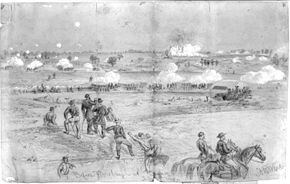29th United States Colored Infantry Regiment
The regiment was officially accepted for service in April 1864 and sent to fight in the Eastern Theater of the American Civil War.
Assigned to an infantry division where all the rank and file were African-American, the unit guarded the army wagon train and dug trenches for a few weeks.
The unit transferred to Texas and was probably present in Galveston when Union General Gordon Granger announced emancipation on Juneteenth (19 June 1865).
After President Abraham Lincoln issued the Emancipation Proclamation on 1 January 1863, he requested that four regiments should be raised from African-Americans.
Of the personnel assigned to these regiments, 143 (white) officers and 2,751 (black) enlisted men were killed or died of their wounds.
[1] In late 1863, Illinois Governor Richard Yates issued an executive order that prescribed how the regiment would be raised.
Initially, there was a stigma attached to white officers in the colored regiments, but this was quickly overcome by the prospect of rapid promotion.
[3] The 29th United States Colored Infantry Regiment (29th USCI) was organized at Quincy, Illinois and mustered into Federal service on 24 April 1864.
Bross formerly commanded Company A of the 88th Illinois Infantry Regiment and was a veteran of the Battle of Stones River.
The commander of the all-black 4th Division was Brigadier General Edward Ferrero whose earlier career was described by one author as "questionable".
Lieutenant Colonel Henry Pleasants of the 48th Pennsylvania Infantry Regiment, from a coal mining region, proposed a plan to dig a tunnel under the Confederate trenches and use explosives to blast a gap in the defenses.
Believing that black troops were unfit even for picket duty, Meade refused to allow the 4th Division to lead the assault.
Meade convinced Grant by pointing out that if the African-American troops led the attack and were massacred, that the public would believe that the Union Army "did not care anything about them".
[16] In a letter to The Christian Recorder, Sergeant William McCoslin of the 29th USCI wrote on 26 July that the regiment had been building fortifications for the last eight days.
Instead of directing his troops, Ledlie stayed well to the rear in an aid station demanding "stimulants" from a surgeon for his malaria.
As the brigade emerged from the captured trench to rush the ridge, it was hit by a deadly crossfire from musketry and from an eight-gun battery on the right.
[19] Bross led the 29th USCI into battle in full uniform and was fatally wounded while carrying the regimental colors.
[20] In mid-career the second charge was struck by a Confederate brigade from Brigadier General William Mahone's division and overwhelmed.
The subsequent voyage was plagued by storms and some accounts state that the regiment went ashore at Galveston on 18–20 June 1865.
[4] Hicken stated that 49 men deserted and that there were 158 deaths from battle and disease, not counting the many who died in Confederate prisons.


